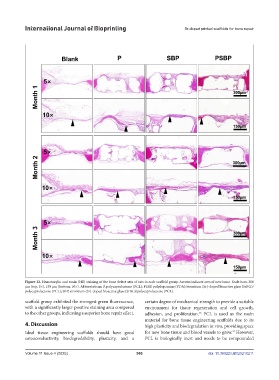Page 374 - v11i4
P. 374
International Journal of Bioprinting Sr-doped printed scaffolds for bone repair
Figure 12. Hematoxylin and eosin (HE) staining of the bone defect area of rats in each scaffold group. Arrows indicate area of new bone. Scale bars: 300
μm (top, 5×), 150 μm (bottom, 10×). Abbreviations: P, polycaprolactone (PCL); PSBP, polydopamine (PDA)/strontium (Sr)-doped bioactive glass (SrBG)/
polycaprolactone (PCL); SBP, strontium (Sr)-doped bioactive glass (SrBG)/polycaprolactone (PCL).
scaffold group exhibited the strongest green fluorescence, certain degree of mechanical strength to provide a suitable
with a significantly larger positive staining area compared environment for tissue regeneration and cell growth,
to the other groups, indicating a superior bone repair effect. adhesion, and proliferation. PCL is used as the main
43
material for bone tissue engineering scaffolds due to its
4. Discussion high plasticity and biodegradation in vivo, providing space
Ideal tissue engineering scaffolds should have good for new bone tissue and blood vessels to grow. However,
44
osteoconductivity, biodegradability, plasticity, and a PCL is biologically inert and needs to be compounded
Volume 11 Issue 4 (2025) 366 doi: 10.36922/IJB025210211

